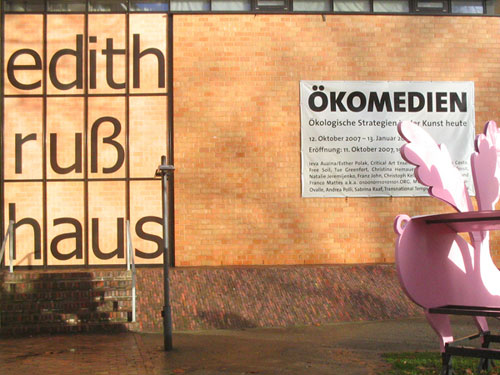
Franz John
Turing Tables. An Untitled Composition for Tectonic Spaces
In der Installation Turing Tables von Franz John taucht der Betrachter in einen Datenstrom ein, der die tektonischen Bewegungen der Erde in Echtzeit auflistet. Über eine Internetverbindung werden die Informationen, die weltweit von tausenden Seismografen registriert werden, in den Ausstellungsraum übertragen und als endlose Abfolge von Schrift und Zahlen in einer Raum füllenden Projektion wiedergegeben. Die Menge der global ermittelten Daten zu Ort, Zeit und Intensität der Erdbewegungen und die fortlaufende Aktualisierung der Messungen sind zunächst nur in ihrer unermesslichen Fülle wahrnehmbar, als grüne Schrift- und Zahlenkolonnen, mit denen der Betrachter konfrontiert ist. Diese Daten werden jedoch nicht nur sichtbar, sondern auch hörbar und spürbar gemacht: Ein Computerprogramm konvertiert die wissenschaftlichen Fakten und Zahlen in Klänge und macht die ansonsten für den Betrachter abstrakt bleibenden Erdbebendaten physisch erfahrbar. Das Grollen der Erde, die ständige Bewegung, in der sich die tektonischen Platten befinden, wird über Klangvibrationen eindrücklich nachvollziehbar. Die Naturgewalt der Erde ist Thema von Turing Tables. John wählt dabei allerdings nicht den Blick des naturverbundenen Romantikers, sondern spürt ihr mithilfe modernster Technik, globalen Netzwerken und Kommunikationstechnologien wie dem Internet, nach. Die dadurch ermöglichte Darstellung und Vernetzung weltweiter Daten erlaubt einen Blick auf das Ganze; die Erde wird als Organismus begreifbar. Der Titel der Arbeit bezieht sich auf die »universelle Maschine«, die Turing Machine, die der britische Mathematiker Alan Turing bereits 1935 skizziert hatte. Diese sollte Berechnungen durchführen und kann als Vorläufer des modernen Computers betrachtet werden. Auf paradigmatische Weise macht John deutlich, wie unser Bild der Erde vom Einsatz technischer Methoden und Verfahren mitbestimmt ist. So wurden erst 1968 durch Satellitenaufnahmen Bilder der Erde vom All aus möglich, die heute bestimmend für unsere Vorstellung vom blauen Planeten sind. Die Arbeit visualisiert und sonifiziert Erdbebendaten, wobei sie nicht die Bedrohlichkeit dieser tektonischen Bewegungen in den Vordergrund rückt, sondern die Erde als Organismus, den es zu schützen gilt.
Sabine Himmelsbach
Ausstellung: Ökomedien | Ecomedia 12. Okt. 2007 - 13. Jan. 2008
http://www.edith-russ-haus.de/german/ecomedia.html
Franz John
Turing Tables. An Untitled Composition for Tectonic Spaces
In the Franz John installation Turing Tables, the viewer is plunged into a datastream that lists the
tectonic movements of the earth in real time. Via an internet link, data recorded worldwide by
thousands of seismographs are transmitted to the exhibition room and reproduced as an endless
sequence of writing and numbers. The quantity of globally registered information on places, times
and the intensity of earth movements and the ongoing updating of the measurements is at first only
perceptible as immeasurable, as green writing and columns of figures with which viewers are
confronted. These data have, however, been rendered audible and palpable and not just visible: a
software programme converts the scientific facts and numbers into sounds, thus making it possible
for viewers to physically experience earthquake data that would otherwise remain abstract. The
rumble of the earth, the constant grinding of its tectonic plates, become impressively perceptible
through sound vibrations. The earth as nature at its most awesomely powerful is the subject of
Turing Tables. John, however, has not chosen the viewpoint of a nature-loving Romantic but instead
tracks his subject down with the aid of state-of-the-art technology—global networks and
communications technologies such as the internet. The representation and interlinking of data
worldwide made possible through this approach gives a view of the whole; the earth is perceived as
an organism. The title of the work refers to the “universal machine,” the Turing Machine
sketched back in 1935 by the British mathematician Alan Turing. Supposed to carry out calculations,
it can be regarded as the forerunner of the modern computer. John makes paradigmatically clear how
the way we see the earth is co-determined by the use of technology-based methods and procedures.
Pictures of the earth as viewed from space were made possible via satellite in 1968 and they still
shape our ideas of the blue planet. John’s work visualises and sonifies earthquake data
although he has given priority to the earth as an organism that must be protected rather than the
threat posed by these tectonic movements.
Sabine Himmelsbach
Exhibition: Ökomedien | Ecomedia Oct-12-2007 - Jan-13-2008
http://www.edith-russ-haus.de/english/ecomedia.html
Ausstellungen Exhibitions 2007
- Edith-Russ-Haus für Medienkust, Oldenburg, DE
- Melkweg, Amsterdam, NL